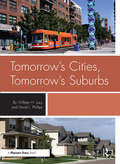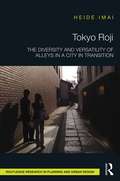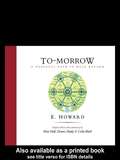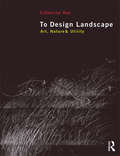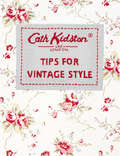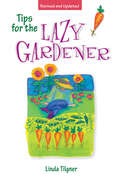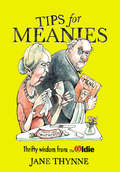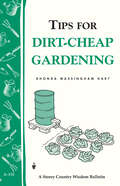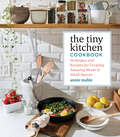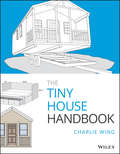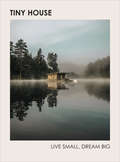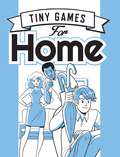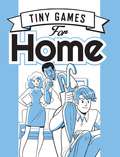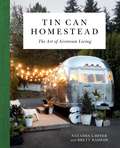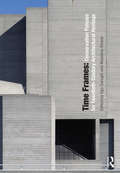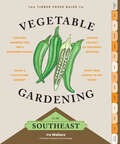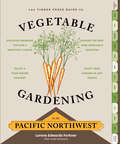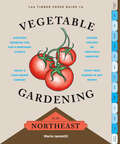- Table View
- List View
Tony Hunt's Second Sketchbook
by Tony Hunt Sir Norman FosterTony Hunt's Sketchbook illustrates the connection between brain and hand in conceiving structural concepts and details as possible solutions to structures in architecture. This new edition features 100 previously unpublished sketches. These sketches illustrate alternative structural concepts, ideas and details developed by Tony Hunt for over one hundred projects throughout his professional life. They relate directly to projects built and unbuilt in the field of structural engineering and were either produced at the time of relevant design meetings or as a response to a problem posed by an architect and are, therefore, a record of ideas proposed at the particular time. They are a source of design inspiration and an insight into the work of this well respected engineer.
Tomorrow's Cities, Tomorrow's Suburbs
by William LucyCities ruled the first half of the 20th century; the second half belonged to the suburbs. Will cities become dominant again? Can the recent decline of many suburbs be slowed? This book predicts a surprising outcome in the decades-long tug-of-war between urban hubs and suburban outposts. The authors document signs of resurgence in cities and interpret omens of decline in many suburbs. They offer an extensive analysis of the 2000 census, with insights into the influence of income disparities, housing age and size, racial segregation, immigration, and poverty. They also examine popular perceptions-and misperceptions-about safety and danger in cities, suburbs, and exurbs that affect settlement patterns. This book offers evidence that the decline of cities can continue to be reversed, tempered by a warning of a mid-life crisis looming in the suburbs. It also offers practical policies for local action, steps that planners, elected officials, and citizens can take to create an environment in which both cities and suburbs can thrive.
Tomorrow's Cities, Tomorrow's Suburbs
by William LucyCities ruled the first half of the 20th century; the second half belonged to the suburbs. Will cities become dominant again? Can the recent decline of many suburbs be slowed? This book predicts a surprising outcome in the decades-long tug-of-war between urban hubs and suburban outposts. The authors document signs of resurgence in cities and interpret omens of decline in many suburbs. They offer an extensive analysis of the 2000 census, with insights into the influence of income disparities, housing age and size, racial segregation, immigration, and poverty. They also examine popular perceptions-and misperceptions-about safety and danger in cities, suburbs, and exurbs that affect settlement patterns. This book offers evidence that the decline of cities can continue to be reversed, tempered by a warning of a mid-life crisis looming in the suburbs. It also offers practical policies for local action, steps that planners, elected officials, and citizens can take to create an environment in which both cities and suburbs can thrive.
Tokyo Roji: The Diversity and Versatility of Alleys in a City in Transition
by Heide ImaiThe Japanese urban alleyway, which was once part of people’s personal spatial sphere and everyday life has been transformed by diverse and competing interests. Marginalised through the emergence of new forms of housing and public spaces, re-appropriated by different fields, and re-invented by the contemporary urban design discourse, the social meaning attached to the roji is being re-interpreted by individuals, subcultures and new social movements. The book will introduce and discuss examples of urban practices which take place within the dynamic urban landscape of contemporary Tokyo to portray the life cycle of an urban form being rediscovered, commodified and lost as physical space.
Tokyo Roji: The Diversity and Versatility of Alleys in a City in Transition
by Heide ImaiThe Japanese urban alleyway, which was once part of people’s personal spatial sphere and everyday life has been transformed by diverse and competing interests. Marginalised through the emergence of new forms of housing and public spaces, re-appropriated by different fields, and re-invented by the contemporary urban design discourse, the social meaning attached to the roji is being re-interpreted by individuals, subcultures and new social movements. The book will introduce and discuss examples of urban practices which take place within the dynamic urban landscape of contemporary Tokyo to portray the life cycle of an urban form being rediscovered, commodified and lost as physical space.
To-Morrow: A Peaceful Path to Real Reform (Cambridge Library Collection - British And Irish History, 19th Century Ser.)
by Sir Peter Hall Dennis Hardy E. Howard Colin WardTo celebrate the centenary of the first garden city at Letchworth, the Town and Country Planning Association has performed a service to planners everywhere by initiating the republication in facsimile form of the very scarce original first edition of To-Morrow. Accompanied by a running scholarly commentary on the text, and by a newly-written editorial introduction and postscript, jointly written by three leading commentators on Howard's life and work To-Morrow will immediately become a compulsory purchase for every serious student and practitioner of planning and for teachers and students of modern social, economic and political history.
To-Morrow: A Peaceful Path to Real Reform
by Sir Peter Hall Dennis Hardy E. Howard Colin WardTo celebrate the centenary of the first garden city at Letchworth, the Town and Country Planning Association has performed a service to planners everywhere by initiating the republication in facsimile form of the very scarce original first edition of To-Morrow. Accompanied by a running scholarly commentary on the text, and by a newly-written editorial introduction and postscript, jointly written by three leading commentators on Howard's life and work To-Morrow will immediately become a compulsory purchase for every serious student and practitioner of planning and for teachers and students of modern social, economic and political history.
To Design Landscape: Art, Nature & Utility
by Catherine DeeTo Design Landscape sets out a distinctively practical philosophy of design, in accessible format. Based on the notion that landscape design is a form-based craft addressing environmental processes and utility, Dee establishes a framework for approaching such craft with modesty and ingenuity, using the concept of "aesthetics of thrift".Employing numerous case studies-as diverse as Hellerup Rose Garden in Denmark; Bloedel Reserve, Bainbridge Island, USA; Rousham Gardens, Oxfordshire, UK and Tofuku-ji, in Kyoto, Japan - to illustrate her ideas, the book is a beautiful portfolio of Dee's drawings, which are both evocative and to the point.The book begins with a 'Foundations' section, which sets out the basis of the approach. ?'Principles' chapters then elaborate eleven significant considerations applicable to any design project, regardless of context and scale. Following on, 'Strategies' chapters reinforce the principles, and suggest further ways of designing, adaptable to different conditions. Dee ends with a focus on 'Elements', case studies and verb lists providing sources for the designer to consider how the components - vegetation, water, terrain, structures, soils, weather, and the sky - ?might be engaged, mediated and joined.Catherine Dee’s book is for all those who would craft landscape, from the gardener, to the professional landscape architect, to the student of design
To Design Landscape: Art, Nature & Utility
by Catherine DeeTo Design Landscape sets out a distinctively practical philosophy of design, in accessible format. Based on the notion that landscape design is a form-based craft addressing environmental processes and utility, Dee establishes a framework for approaching such craft with modesty and ingenuity, using the concept of "aesthetics of thrift".Employing numerous case studies-as diverse as Hellerup Rose Garden in Denmark; Bloedel Reserve, Bainbridge Island, USA; Rousham Gardens, Oxfordshire, UK and Tofuku-ji, in Kyoto, Japan - to illustrate her ideas, the book is a beautiful portfolio of Dee's drawings, which are both evocative and to the point.The book begins with a 'Foundations' section, which sets out the basis of the approach. ?'Principles' chapters then elaborate eleven significant considerations applicable to any design project, regardless of context and scale. Following on, 'Strategies' chapters reinforce the principles, and suggest further ways of designing, adaptable to different conditions. Dee ends with a focus on 'Elements', case studies and verb lists providing sources for the designer to consider how the components - vegetation, water, terrain, structures, soils, weather, and the sky - ?might be engaged, mediated and joined.Catherine Dee’s book is for all those who would craft landscape, from the gardener, to the professional landscape architect, to the student of design
Tips For Vintage Style
by Cath KidstonCath Kidston's easy style conjures up a way of life that many aspire to but few achieve. Described in the Times as 'the other domestic goddess', and in the Daily Telegraph as 'the woman who made cabbage roses funky, and delivered nursery prints, polka dots and candy stripes to modern bohemia', her look is desirable and accessible. Tips for Vintage Style distills the essence from Vintage Style, giving you the ultimate book of interior design ideas for your home. Covering kitchens, bedrooms, bathrooms, sitting rooms and even home offices, Cath's practical and inspirational interior design advice will show you how the smallest steps can make the biggest differences. You will see the best ways to use up leftover wallpaper and fabric, discover how to make your bathroom a haven, get tips on the best places to find the best old furniture and kitchenware - in short you will learn how to create a home that will be the envy of all your friends.
Tips for the Lazy Gardener
by Linda TilgnerLinda Tilger encourages you to embrace the lazy gardener within to work smarter and relax harder. With hundreds of time-saving techniques, Tips for the Lazy Gardener shows you how easy it can be to grow hearty vegetables and fragrant herbs. Covering everything from planning an efficient garden to effective shortcuts for harvesting your crops, Tilga&’s expert suggestions are designed to mitigate chore time while increasing your gardening pleasure. Enjoy a thriving and abundant garden — without all the back-breaking, energy-sapping work.
Tips for Meanies: Thrifty Wisdom from The Oldie
by Jane ThynneTips for Meanies is an irreverent guide to thrift, the perfect present for the Meanies in your life that will equip them with new, versatile weapons for their armoury:- Discover the penny-pinching potential of everyday miracle products, from toothpaste and vinegar to barbecue briquettes- Find cunning ways to curb household shopping and energy bills- Avoid pricey trips to the chemist by channelling the healing powers of cheap and easy home remedies… everything Meanies need to keep their household clean, green – and very mean.
Tips for Dirt-Cheap Gardening: Storey Country Wisdom Bulletin A-158 (Storey Country Wisdom Bulletin)
by Rhonda Massingham HartSince 1973, Storey's Country Wisdom Bulletins have offered practical, hands-on instructions designed to help readers master dozens of country living skills quickly and easily. There are now more than 170 titles in this series, and their remarkable popularity reflects the common desire of country and city dwellers alike to cultivate personal independence in everyday life.
The Tiny Kitchen Cookbook: Strategies and Recipes for Creating Amazing Meals in Small Spaces
by Annie MahleWhether home is a small apartment, a tiny house or RV, a boat, or a college dorm room, space in the kitchen is nearly always at a premium. But cooking in a small kitchen, with minimal equipment, doesn't have to be limiting; it can actually be is a great opportunity to hone food-prep skills and become a more efficient, versatile home chef. And the smarter the workspace, the easier it is to cook. In The Tiny Kitchen Cookbook, chef Annie Mahle shares her small-space cooking strategies and 50 of her favorite recipes she developed as the galley chef aboard the J&E Riggin, a windjammer she operated with her husband off the coast of Maine for many summers. From her 6-by-8-foot kitchen, she prepared three beautiful, flavorful meals from scratch every day, for up to 30 people. From versatile breakfast options, such as Sweet Corn and Jalapeno Pancakes or Pan Roasted Honey Pears with Oatmeal, to one-bowl salads and mains, stovetop meals such as Pan-Fried Red Snapper with Fresh Peas, Shiitakes, and Asparagus with Dill, dishes that can be prepared in the toaster oven (for cooks without a full oven) such as Cheese-Stuffed Meatballs with Fresh Tomato Sauce and Fettuccini, and even make-ahead desserts in a mug, every recipe is delicious and utterly attainable in a kitchen with as little as six square feet of counter space. Along with gorgeous recipes, Mahle delivers tips and techniques for making the most of a small kitchen. Strategies such as &“shopping&” the pantry before going to the store, transforming leftovers into new meals, create vertical storage options, and buy utensils that nest all help create meals with maximum flavor in minimal space. This publication conforms to the EPUB Accessibility specification at WCAG 2.0 Level AA.
The Tiny House Handbook
by Charlie Wing“This thought provoking book is a great resource for anyone considering joining the tiny house movement. It’s all the information you need in one book! The author has done a phenomenal job blending real world experience, data and practical knowledge on all types of tiny homes.”-Corinne Watson, Principle and Co-Founder, Tiny Homes of Maine“Charlie Wing’s very readable Tiny House Handbook leads you through the processes of designing and building a tiny home, with careful attention to all the details, including legal issues, cost estimates, material utilization and foundation options. Charlie is a master at demystifying the seemingly complex process of homebuilding. This book will help you live both comfortably and lighter on the land.“-John S. Crowley, CEO of FACET and Board member, Build It GreenPlan, design, and build a tiny house from scratch The Tiny House Handbook is a comprehensive guide to everything you need to know to construct your very own tiny house. Produced in Charlie Wing’s signature “visual handbook” style and jam-packed with full-color illustrations and diagrams, this book includes step-by-step instructions for building a tiny house as well as information on cost estimating and design requirements. Based on 2018 International Residential Code (IRC) Appendix Q, this book includes sample construction drawings and floor plans for a variety of tiny home styles, including: · Mobile (8'6”-wide trailers and RVs) · Movable (12'-wide, routine transport permit) · Site-built (up to 20’ wide) Rather than being just another inspirational collection of tiny home photographs, The Tiny House Handbook constitutes a complete and fulsome reference for anyone seeking to build their own tiny home. From seasoned construction vets to total novices, this book will walk you through the process of designing and building a tiny house from start to finish.
The Tiny House Handbook
by Charlie Wing“This thought provoking book is a great resource for anyone considering joining the tiny house movement. It’s all the information you need in one book! The author has done a phenomenal job blending real world experience, data and practical knowledge on all types of tiny homes.”-Corinne Watson, Principle and Co-Founder, Tiny Homes of Maine“Charlie Wing’s very readable Tiny House Handbook leads you through the processes of designing and building a tiny home, with careful attention to all the details, including legal issues, cost estimates, material utilization and foundation options. Charlie is a master at demystifying the seemingly complex process of homebuilding. This book will help you live both comfortably and lighter on the land.“-John S. Crowley, CEO of FACET and Board member, Build It GreenPlan, design, and build a tiny house from scratch The Tiny House Handbook is a comprehensive guide to everything you need to know to construct your very own tiny house. Produced in Charlie Wing’s signature “visual handbook” style and jam-packed with full-color illustrations and diagrams, this book includes step-by-step instructions for building a tiny house as well as information on cost estimating and design requirements. Based on 2018 International Residential Code (IRC) Appendix Q, this book includes sample construction drawings and floor plans for a variety of tiny home styles, including: · Mobile (8'6”-wide trailers and RVs) · Movable (12'-wide, routine transport permit) · Site-built (up to 20’ wide) Rather than being just another inspirational collection of tiny home photographs, The Tiny House Handbook constitutes a complete and fulsome reference for anyone seeking to build their own tiny home. From seasoned construction vets to total novices, this book will walk you through the process of designing and building a tiny house from start to finish.
Tiny House: Live Small, Dream Big
by Brent HeavenerHaving less is the secret to living more. Whether you’ve been dreaming about a treehouse in the wilderness of Montana, or a remote eco-cabin in Patagonia or Australia; driving a campervan on the open roads of Quebec, or floating on a houseboat in Sweden – find escape, inspiration and a window into a freer, simpler, happier kind of life. In this visual manifesto for the tiny house lifestyle, discover over 250 awe-inspiring images of the world’s most creative small homes, alongside the stories, ideas and advice of those living in them. Curated by the founder of the #1 @tinyhouse Instagram feed.Sometimes you have to think small to live BIG.
Tiny Games for Home (Osprey Games Ser.)
by Hide Seek Paulina GanucheauDesigned to give the maximum amount of fun for the minimum amount of rule-reading, Tiny Games for Home will let you find the perfect game for whatever situation you're in. All you need is this book, and the stuff that's around you. (Friends optional) There are games to play with spoons and sofas and TVs and turnips and books and bottles. Games about words, games about celebrities, games about the things and the people and the places in your life. Games for TV commercial breaks, games for toast, and games for lying in bed. Whether you're feeling creative or competitive, silly or energetic, we've got you covered."It's like carrying around a collection of Victorian parlour games – except the Tiny Games take advantage of modern social settings and contexts. They're amusing, raucous and inventive†? - The Guardian
Tiny Games for Home
by Hide Seek Paulina GanucheauDesigned to give the maximum amount of fun for the minimum amount of rule-reading, Tiny Games for Home will let you find the perfect game for whatever situation you're in. All you need is this book, and the stuff that's around you. (Friends optional) There are games to play with spoons and sofas and TVs and turnips and books and bottles. Games about words, games about celebrities, games about the things and the people and the places in your life. Games for TV commercial breaks, games for toast, and games for lying in bed. Whether you're feeling creative or competitive, silly or energetic, we've got you covered."It's like carrying around a collection of Victorian parlour games – except the Tiny Games take advantage of modern social settings and contexts. They're amusing, raucous and inventive†? - The Guardian
Tin Can Homestead: The Art of Airstream Living
by Natasha LawyerDIY enthusiasts, tiny house-lovers, and van-lifers will find inspiration and step-by-step instructions in Tin Can Homestead, the ultimate resource for living small in your own Airstream paradise. The Airstream trailer is the ultimate symbol of vintage wanderlust-and the classic touring vehicle's resurgent popularity has dovetailed with the tiny house movement, resonating with design-minded individuals looking to live small. Tin Can Homestead, based on the popular Instagram of the same name, is the ultimate resource for these would-be DIY-ers, and the perfect coffee-table addition for anyone looking for streamlined, modern lifestyle inspiration. Part practical how-to, part lushly illustrated design inspiration, Tin Can Homestead follows the story of one couple as they build themselves a new life in an old Airstream. Through personal stories and down-and-dirty checklists, this book guides readers through all stages of creating their own Airstream homes-from buying a trailer to plumbing and electrical work. With a hip, bohemian aesthetic and a fresh authorial voice, the authors pair their DIY knowledge with lifestyle advice-including dér, design, and entertaining-and abundant illustrations, from in-process photographs to hand-drawn illustrations.
Time Frames: Conservation Policies for Twentieth-Century Architectural Heritage
by Ugo Carughi Massimo VisoneTime Frames provides a reconnaissance on the conservation rules and current protection policies of more than 100 countries, with particular attention to the emerging nations and twentieth-century architecture. The contributions illustrate the critical issues related to architectural listings, with a brief history of national approaches, a linkography and a short bibliography. The book also provides a short critical lexicography, with 12 papers written by scholars and experts including topics on identities, heritages, conservation, memories and the economy. By examining the methods used to designate building as heritage sites across the continents, this book provides a comprehensive overview of current protection policies of twentieth-century architecture as well as the role of architectural history.
Time Frames: Conservation Policies for Twentieth-Century Architectural Heritage
by Ugo Carughi Massimo VisoneTime Frames provides a reconnaissance on the conservation rules and current protection policies of more than 100 countries, with particular attention to the emerging nations and twentieth-century architecture. The contributions illustrate the critical issues related to architectural listings, with a brief history of national approaches, a linkography and a short bibliography. The book also provides a short critical lexicography, with 12 papers written by scholars and experts including topics on identities, heritages, conservation, memories and the economy. By examining the methods used to designate building as heritage sites across the continents, this book provides a comprehensive overview of current protection policies of twentieth-century architecture as well as the role of architectural history.
The Timber Press Guide to Vegetable Gardening in the Southeast (Regional Vegetable Gardening Series)
by Ira WallaceThis Timber Press Guide features an A–Z section that profiles the 50 vegetables, fruits, and herbs that grow best in the Southeast and provides basic care and maintenance for each.
The Timber Press Guide to Vegetable Gardening in the Pacific Northwest (Regional Vegetable Gardening Series)
by Lorene Edwards ForknerThis Timber Press Guide features an A–Z section that profiles the 50 vegetables, fruits, and herbs that grow best in the Pacific Northwest and provides basic care and maintenance for each.
The Timber Press Guide to Vegetable Gardening in the Northeast (Regional Vegetable Gardening Series)
by Marie IannottiThis Timber Press Guide features an A–Z section that profiles the 50 vegetables, fruits, and herbs that grow best in the Northeast and provides basic care and maintenance for each.

